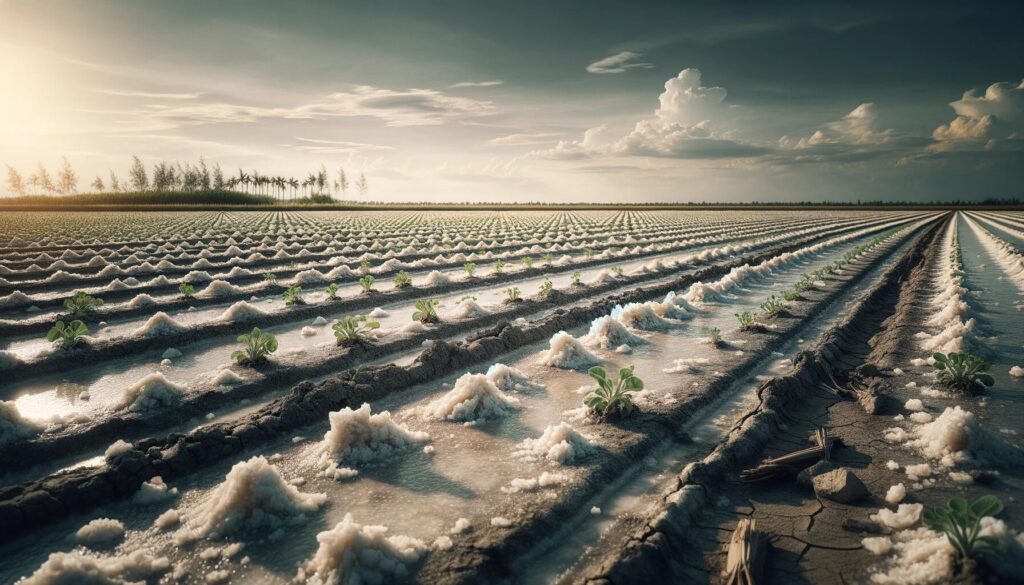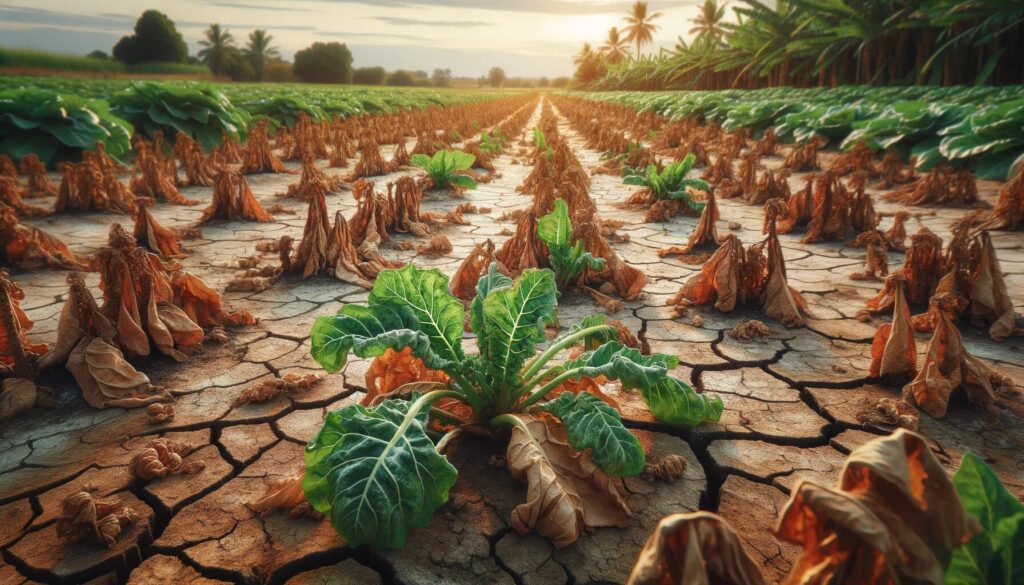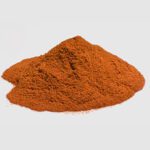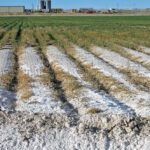What are Sodic Saline Soils?
Sodic saline soils are a type of soil that has high levels of soluble salts, particularly sodium salts (Na+), which can have a negative impact on agriculture. These soils are characterized by having a high concentration of sodium ions in relation to other cations such as calcium (Ca2+) and magnesium (Mg2+). The sodium/calcium (Na/Ca) ratio and the sodium/magnesium (Na/Mg) ratio are important parameters for determining the quality of a sodic saline soil.

Adverse Effects of Sodium in Agriculture
The excessive presence of sodium in these soils can have several adverse effects on agriculture:
- Soil Structure Problems: Sodium can disperse soil particles, leading to the formation of unstable soil aggregates. This results in poor soil structure that hinders water infiltration and air flow, which in turn affects plant growth.
- Salt Accumulation: The high concentration of soluble salts in these soils can be toxic to plants, as they can interfere with the absorption of essential nutrients, such as potassium (K+), and cause osmotic stress in the roots.
- Drainage Difficulties: The poor soil structure and high salinity can lead to drainage problems, which can increase the risk of waterlogging and salinization.

To improve the quality of sodic saline soils, it is necessary to carry out appropriate management practices, such as the application of amendments to replace sodium with calcium and magnesium, soil flushing with quality water, and the implementation of effective drainage systems. Proper management of these soils is essential to optimize agricultural production in areas affected by soil salinity and sodicity.
Plant Tolerance to Sodic Saline Soils
The tolerance of crops to sodic saline soils varies depending on the plant species and its ability to adapt to adverse conditions. Sodic saline soils can be a challenge for agriculture, as the presence of high concentrations of sodium and salinity can negatively affect the growth and development of many plants. However, some crop species are more tolerant than others to these conditions. Here are some considerations on crop tolerance to sodic saline soils:

- Tolerant: Some crops are naturally more tolerant to sodic saline soils than others. For example, certain grasses and forages, like alfalfa (Medicago sativa), Sudan grass (Sorghum sudanense), and saltbush (Atriplex spp.), have a higher tolerance to salinity and sodium compared to broadleaf crops like corn or wheat.
- Resistant Varieties: Within a crop species, there may be varieties that are more resistant to salinity and sodium than others. Selecting appropriate varieties can be key to success in sodic saline soils.
- Management Practices: Proper management of sodic saline soils can improve crop tolerance. This includes improving soil structure, correcting the sodium/calcium and sodium/magnesium ratio through the application of amendments, and managing irrigation to reduce the accumulation of salts in the root zone.
- Crop Rotation: Rotating crops with plants more resistant to salinity can help reduce stress on the soil and improve soil quality over time.
- Proper Irrigation: Irrigation management is crucial in sodic saline soils. Irrigating with quality water and irrigation techniques that minimize the accumulation of salts in the root zone, such as drip irrigation, can be beneficial.
- Use of Phytostabilization: In some areas, halophytic plants (plants that tolerate high concentrations of salinity) can be used to improve soil quality over time through phytostabilization.
Horticultural Crops
| Crop | EC Limit (a) (dS/m) | Type of Tolerance |
| Onion | 1.2 | Sensitive |
| Spring Onion | 1.2 | Sensitive |
| Pea | 1.5 | Sensitive |
| Bean | 1 | Sensitive |
| Carrot | 1 | Sensitive |
| Alfalfa | 2 | Moderately Sensitive |
| Celery | 1.8 | Moderately Sensitive |
| Oats | 1.7 | Moderately Sensitive |
| Eggplant | 1.1 | Moderately Sensitive |
| Broccoli | 2.8 | Moderately Sensitive |
| Squash | 1.2 | Moderately Sensitive |
| Cauliflower | 1.8 | Moderately Sensitive |
| Spinach | 2 | Moderately Sensitive |
| Sunflower | 1.7 | Moderately Sensitive |
| Green Bean | 1.6 | Moderately Sensitive |
| Lettuce | 1.25 | Moderately Sensitive |
| Flax | 1.7 | Moderately Sensitive |
| Sweet Corn | 1.7 | Moderately Sensitive |
| Corn | 1.7 | Moderately Sensitive |
| Watermelon | 0.9 | Moderately Sensitive |
| Tomato | 2 | Moderately Sensitive |
| Artichoke | 6.1 | Moderately Sensitive |
| Sorghum | 6.8 | Moderately Sensitive |
| Wheat | 6 | Moderately Sensitive |
| Cotton | 7.7 | Tolerant |
| Barley | 8 | Tolerant |
Woody Crops:
| Crop | EC Limit (a) (dS/m) | Type of Tolerance |
| Onion | 1.2 | Sensitive |
| Spring Onion | 1.2 | Sensitive |
| Pea | 1.5 | Sensitive |
| Bean | 1 | Sensitive |
| Carrot | 1 | Sensitive |
| Alfalfa | 2 | Moderately Sensitive |
| Celery | 1.8 | Moderately Sensitive |
| Oat | 1.7 | Moderately Sensitive |
| Eggplant | 1.1 | Moderately Sensitive |
| Broccoli | 2.8 | Moderately Sensitive |
| Pumpkin | 1.2 | Moderately Sensitive |
| Cauliflower | 1.8 | Moderately Sensitive |
| Spinach | 2 | Moderately Sensitive |
| Sunflower | 1.7 | Moderately Sensitive |
| Green Bean | 1.6 | Moderately Sensitive |
| Lettuce | 1.25 | Moderately Sensitive |
| Flax | 1.7 | Moderately Sensitive |
| Sweet Corn | 1.7 | Moderately Sensitive |
| Corn Grain | 1.7 | Moderately Sensitive |
| Melon | 1.7 | Moderately Sensitive |
| Potato | 1.7 | Moderately Sensitive |
| Cucumber | 2 | Moderately Sensitive |
| Bell Pepper | 1.5 | Moderately Sensitive |
| Radish | 1.2 | Moderately Sensitive |
| Watermelon | 0.9 | Moderately Sensitive |
| Tomato | 2 | Moderately Sensitive |
| Artichoke | 6.1 | Moderately Sensitive |
| Sorghum Grain | 6.8 | Moderately Sensitive |
| Wheat | 6 | Moderately Sensitive |
| Cotton | 7.7 | Tolerant |
| Barley | 8 | Tolerant |
Woody Crops:
| Crop | EC Limit (a) (dS/m) | Type of Tolerance |
| Avocado | 1.60 | Sensitive |
| Apricot | 1.60 | Sensitive |
| Almond | 1.50 | Sensitive |
| Cherry | 1.50 | Sensitive |
| Plum | 1.50 | Sensitive |
| Persimmon | 1.70 | Sensitive |
| Mandarin | 1.70 | Sensitive |
| Apple | 1.50 | Sensitive |
| Bitter Orange x Lemon | 1.50 | Sensitive |
| Lemon x Citrus Macrophylla | 1.21 | Sensitive |
| Peach | 1.70 | Sensitive |
| Orange | 1.70 | Sensitive |
| Loquat | 1.60 | Sensitive |
| Pear | 1.50 | Sensitive |
| Grapefruit | 1.70 | Sensitive |
| Lemon x Mandar. Cleopatra | 1.92 | Moderately Sensitive |
| Lemon | 1.50 | Moderately Sensitive |
| Vine | 1.50 | Moderately Sensitive |
| Pomegranate | 5.00 | Moderately Sensitive |
| Fig | 4.20 | Moderately Sensitive |
| Olive | 5.00 | Moderately Sensitive |
| Palm | 4.00 | Tolerant |
 AgronoBlog – Agriculture Blog
AgronoBlog – Agriculture Blog 


